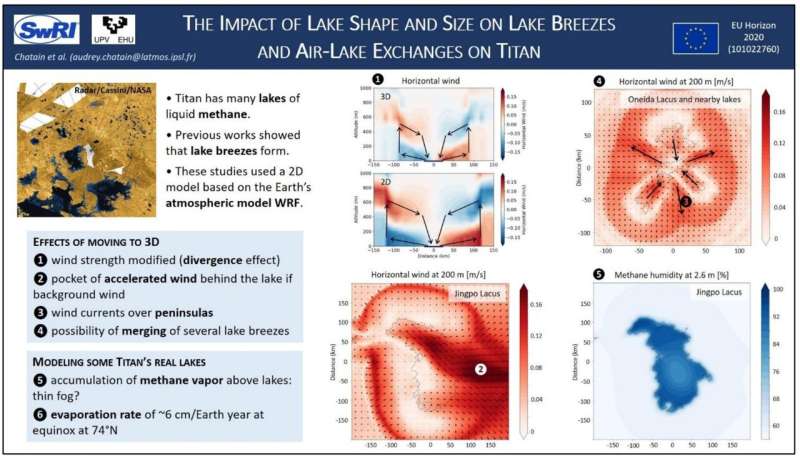October 4, 2023 report
This article has been reviewed according to Science X's editorial process and policies. Editors have highlighted the following attributes while ensuring the content's credibility:
fact-checked
preprint
trusted source
proofread
Creating a 3D model of methane lake impact on local weather on Titan

A team of Earth and planetary scientists from the Southwest Research Institute, Yale University, Université Paris-Saclay, Universidad del País Vasco/Euskal Herriko Unibertsitatea and Sorbonne Université has created a 3D model to show the likely impact of methane lakes on local weather on Saturn's largest moon, Titan. They have published a paper on the arXiv preprint server describing the factors that went into their model and comparing it with 2D models.
Prior research has shown that the primary drivers of weather on Earth are sunlight and water. Prior research has also shown that the primary drivers of weather on Titan are sunlight and methane. To better understand how weather might work on Titan, scientists have applied 2D models originally created to better understand conditions on the Earth's moon. In this new effort, the research team added new features to such models to allow them to better show the impact of different physical features on weather in other places, such as on Titan.
Creating a 3D model to simulate weather on Titan began with use of pictures taken by the ESA's Huygen space probe back in 2005 as it descended to the surface—they showed a complex landscape, including land areas, lakes and rivers. Later it was found that instead of water, the lakes and rivers were filled with methane, which on Titan can take the form of ice, gas or liquid.
For this to occur, logic suggests, weather must drive these dynamics. And that suggests that weather on Titan must be impacted locally, as it is on Earth, by features such as lakes, due to differences in rates of temperature change. To simulate such an impact, the research team added the third dimension missing from current models. To do so, they used useful features of 2D models and data from lakes on Earth.
Once the team had a model built that they believed offered a reasonably faithful rendering of weather conditions on Titan, they ran it to see the kinds of impacts a lake would have. The results showed that 2D models tend to overestimate lake breezes and how far they travel over land, while also underestimating other things, such as how much downward atmospheric movement there is behind such lake breezes. They also found that in some cases, certain parts of some lakes may hold enough methane vapor to create thin fogs.
More information: Audrey Chatain et al, The impact of lake shape and size on lake breezes and air-lake exchanges on Titan, arXiv (2023). DOI: 10.48550/arxiv.2309.07042
Journal information: arXiv
© 2023 Science X Network





















